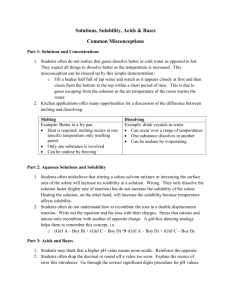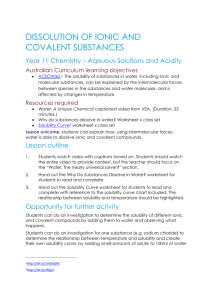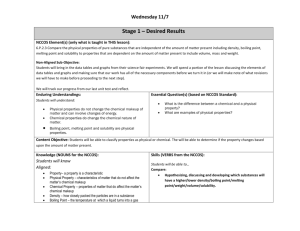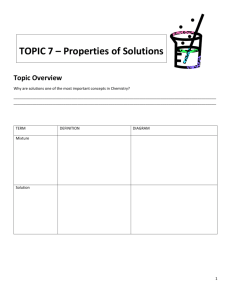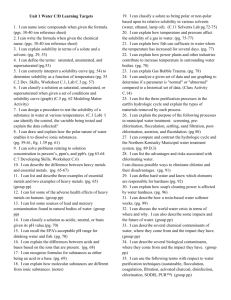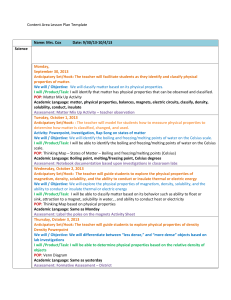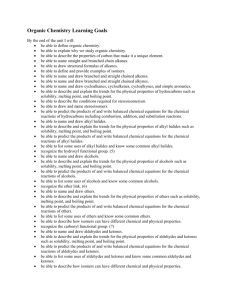Lesson Plans: Unit 1
advertisement
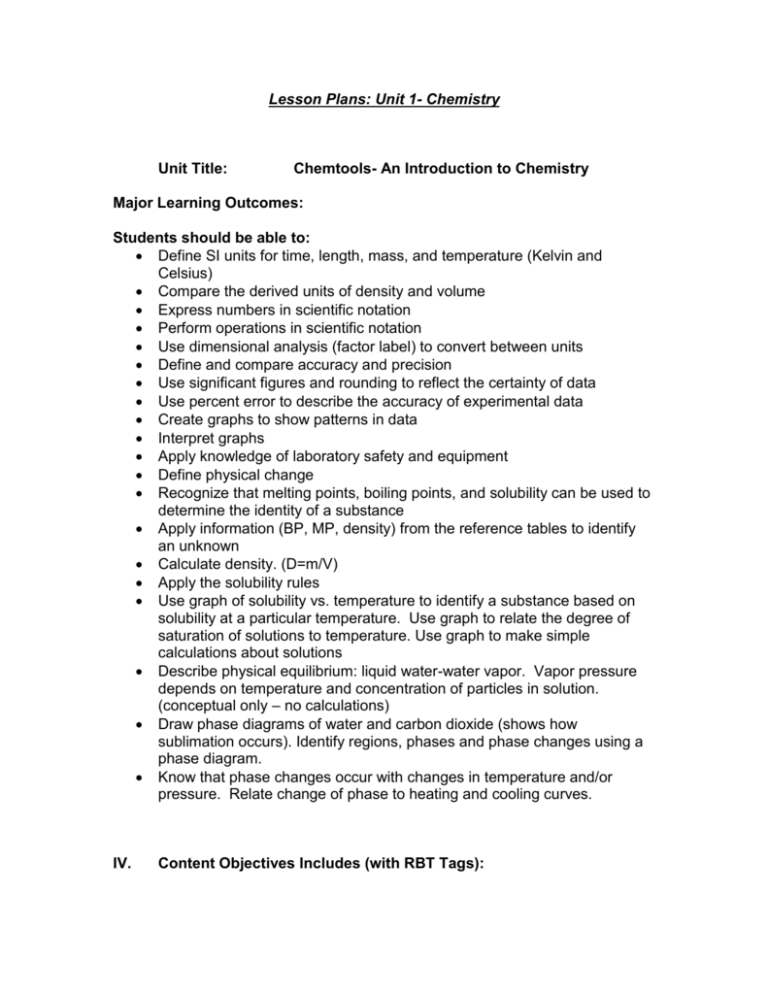
Lesson Plans: Unit 1- Chemistry Unit Title: Chemtools- An Introduction to Chemistry Major Learning Outcomes: Students should be able to: Define SI units for time, length, mass, and temperature (Kelvin and Celsius) Compare the derived units of density and volume Express numbers in scientific notation Perform operations in scientific notation Use dimensional analysis (factor label) to convert between units Define and compare accuracy and precision Use significant figures and rounding to reflect the certainty of data Use percent error to describe the accuracy of experimental data Create graphs to show patterns in data Interpret graphs Apply knowledge of laboratory safety and equipment Define physical change Recognize that melting points, boiling points, and solubility can be used to determine the identity of a substance Apply information (BP, MP, density) from the reference tables to identify an unknown Calculate density. (D=m/V) Apply the solubility rules Use graph of solubility vs. temperature to identify a substance based on solubility at a particular temperature. Use graph to relate the degree of saturation of solutions to temperature. Use graph to make simple calculations about solutions Describe physical equilibrium: liquid water-water vapor. Vapor pressure depends on temperature and concentration of particles in solution. (conceptual only – no calculations) Draw phase diagrams of water and carbon dioxide (shows how sublimation occurs). Identify regions, phases and phase changes using a phase diagram. Know that phase changes occur with changes in temperature and/or pressure. Relate change of phase to heating and cooling curves. IV. Content Objectives Includes (with RBT Tags): Objective Objective Number 2.04 Identify substances using their physical properties: Melting points. Boiling points. Density. Solubility. 2.08 Assess the dynamics of physical equilibria. Interpret phase diagrams. Factors that affect phase changes. RBT Tag C3 B4 Aug 25th EQ: How do you use chemistry in your everyday life? Activities: 1. Go over Course Expectations 2. Fire/Tornado Drill 3. Pass out Textbooks 4. Getting to know you exercise 5. Cornell Notes Homework: 2. Get syllabus signed August 26th EQ: How do you use dimensional analysis in your everyday life? Activities: 1.Define SI units for Time, length, mass and temperature (Kelvin and Celsius) a. Expressing numbers in scientific notation b. Perform operations in scientific notation 1. Pg R58 #s 1-3 (located in the back of the book) 2. Lesson: Dimensional analysis and number usage a. Factor Label method b. Unit conversions 3. Factor label method worksheet practice (groups). Homework: 1. Finish Worksheet 2. Unit 1 Terms 3. Get syllabus signed if you haven’t already August 29th EQ: How does density determine the layering of a liquid mixture? Activities: 1. Go over homework 2. Group Quiz- Dimensional Analysis 3. Critical Reading-Reference tables: Recognize that melting point, boiling point and solubility can be used to determine the identity of a substance. 4. Apply information from reference tables to identify an unknown. 5. Calculate Density D=m/v 6. Solubility Rules 7. Use graph of solubility vs. temperature to identify a substance based on solutbility at a particular temperature. Use graph to relate the segree of saturation of solutions to temperature. (WORKSHEET) 8. Inquiry-Teacher Demo: RED, WHITE, AND BLUE Homework: 1. pg 93 #s 46-56 2. Finish worksheet on solubility if you didn’t finish in class. 3. Unit 1 Terms (Due Monday) August 30 EQ: Describe the changes of state including in matter and how you would determine the state of matter at a specific temperature. Activities: 1. Go over Homework and worksheet on solubility 2. Changes of matter ppt notes 3. Use reference tables to answer questions embedded in ppt. 4. Phase Diagrams: Water and Carbon Dioxide (shows how sublimation occurs) 5. Phase Diagram Practice Homework: 1. Finish Phase Diagram Practice 2. Study/Review For Test 3. Vocab Quiz on Tuesday August 31st EQ: What properties must a solid have to undergo sumblimation? Activities: 1. Go over phase diagram practice 2. Check Vocabulary 3. Vocab Quiz 4. Check Quiz together 5. Review for Test on Unit 1 for tomorrow. Homework: 1. Study for test tomorrow on Unit 1 2. September 1st EQ: What are the dependant factors for Vapor Pressure? Activities: 1. Review/Reiterate 2. Test- Unit 1 3. Vocab for Chapter 4 (Unit 2) Homework: 1. Finish Vocab
